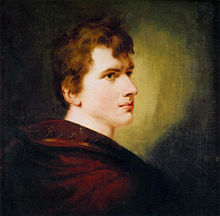German table company


The German Table Society (also known as the Christian-German Table Society in older research ; founding name German Christian Table Cooperative ) was founded in Berlin on January 18, 1811 , the coronation day of the Prussian monarchy, by the poet Achim von Arnim and the state theorist Adam Heinrich Müller existed mainly during the year 1811, but testimonies have also been handed down from later years that prove the continued existence of a dinner party of this name. The founding statutes stipulated that only “decent people” should be invited who were defined as follows: “The society understands by this decency that a man of honor and good morals was born in a Christian religion (...)” It was possible thus an exclusion of baptized Jews and their descendants; the aim was to clearly discriminate against Jews in social life, who were only granted citizenship a year later by the Jewish edict of 1812 as part of the Prussian reforms .
In 1816 a separate circle was formed under Brentano. With August Wilhelm Goetze and Friedrich Karl von Bülow he founded the literary-political evening party of the cockchafer in the conference room of Mr. Mai at the Schloss Freiheit .
Members
The association was founded as part of the reform efforts in Prussia. The members were each half aristocratic and middle class. Among the 86 members known by name, higher professions were particularly represented, including 37 civil servants and 19 soldiers. Among the officials were 12 professors from the Friedrich Wilhelms University, founded in 1809 . The reformist orientation is evident in the low representation of landlords and high nobility. Well-known politicians among the members are the Secret Chief Tax Council Christian Peter Wilhelm Beuth and the Finance Councilor Friedrich August von Staegemann , from the military Carl von Clausewitz and Leopold von Gerlach , from the university lecturers Friedrich Schleiermacher , Johann Gottlieb Fichte and Friedrich Karl von Savigny , by the writers Achim von Arnim and Clemens Brentano , by the other artists August Wilhelm Iffland , Johann Friedrich Reichardt and Karl Friedrich Schinkel . Compared to other associations in Berlin of its time, the German Table Society is described as “more exclusive and open” at the same time.
Positions and table speeches

Anti-French patriotism and anti-Semitism were common attitudes, although not all members permanently. The patriotism of this group was characterized by the conflict with Emperor Napoleon and was primarily Prussian, but secondarily also all-German. Prussian historical myths were often used in the speeches, in particular Frederick the Great and Queen Luise , who died in 1810 , whose life and death were elevated to the symbol of national rebirth and the hoped-for liberation from Napoleonic supremacy.
The best-known texts that were read in the table company are two table speeches, satirical texts in terms of form, Clemens Brentano's Philistine speech and Achim von Arnim's On the Characteristics of Judaism . Brentano describes the type of Philistine whose relatives he depicts the Jews. Arnim's speech is a clearly anti-Semitic text in which Arnim makes use of numerous platitudes of anti-Semitic literature.
Ludolph von Beckedorff gave his farewell speech on June 18, 1811 at the table company, in which he represented strictly anti-Semitic positions and called for the exile of the Jews.
research
For a long time the image of society was shaped by the tendentious construction of the literary historian Reinhold Steig , who portrayed it as part of the reactionary aristocratic opposition to the state chancellor Karl August von Hardenberg . According to Steig, its organ was Heinrich von Kleist's Berliner Abendblätter . These claims were met critically in Kleist research from the very beginning, but Steig's picture remained for a long time in general presentations and handbooks. More recently, this picture has been revised through a return to the sources and more differentiated interpretation. Although the members of their other attitudes can hardly be attributed to eliminatory anti-Semitism, their choice of words in this process came close to it.
literature
- Reinhold Steig: Heinrich von Kleist's Berlin fights. Berlin 1901.
- Jürgen Knaack: Achim von Arnim - not just a poet. Vowinckel-Verlag , Darmstadt 1976, ISBN 3767700220 .
- Stefan Nienhaus: History of the German table society. Niemeyer, Tübingen 2003, ISBN 978-3-484-32115-1 .
- Hannah Arendt : Elements and origins of total domination . 10th edition Piper, Munich 2005, p. 155 ff.
- Jens Bisky : Jokes against philists and Jews. In: Süddeutsche Zeitung , May 18, 2009, No. 113, p. 14.
- Manfred Dickel: Zionism and Young Viennese Modernism. Felix Salten , life and work. Diss. Phil. University of Jena 2003. Chap. 2.1.2., P. 14 ff .: Jewish Salon and German Table Society: The romantic anti-Judaism . (online) .
Individual evidence
- ^ The late work of Clemens Brentano (1815 - 1842): Romanticism in the Age of Metternich's Restoration by Wolfgang Frühwald 1977 p.111
- ↑ Unless otherwise stated, the representation of the members is based on: Stefan Nienhaus: Geschichte der deutschen Tischgesellschaft. Niemeyer Verlag, 2003, ISBN 3484321156 , p. 9 f.
- ↑ Jews, Philistines and Romantic Intellectuals. Reflections on anti-Semitism in Romanticism by Günter Oesterle (edoc server of the Humboldt University in Berlin) Discussions of the table speeches by Clemens Brentano, Achim von Arnim and Adam Müller von Nitterdorf
- ↑ Achim von Arnim: Works (= writings. Vol. 6). Frankfurt 1992, pp. 362-387.
- ^ Text published in 1971 by Heinz Härtl (Halle). Stefan Nienhaus proved the Beckedorffs authorship in 2003.